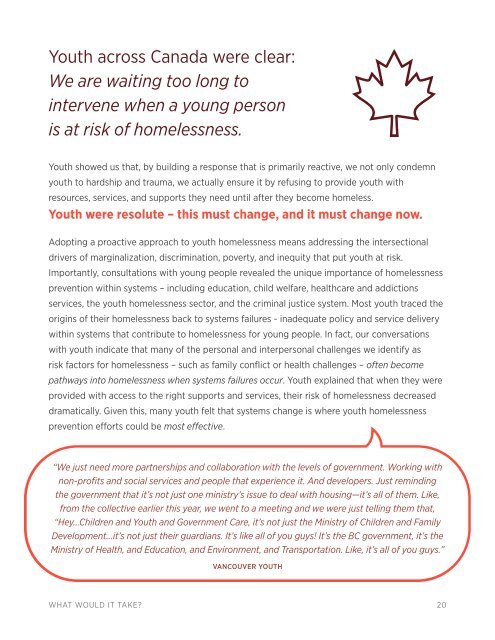COH-AWH-What_Would_it_Take
You also want an ePaper? Increase the reach of your titles
YUMPU automatically turns print PDFs into web optimized ePapers that Google loves.
Youth across Canada were clear:<br />
We are wa<strong>it</strong>ing too long to<br />
intervene when a young person<br />
is at risk of homelessness.<br />
Youth showed us that, by building a response that is primarily reactive, we not only condemn<br />
youth to hardship and trauma, we actually ensure <strong>it</strong> by refusing to provide youth w<strong>it</strong>h<br />
resources, services, and supports they need until after they become homeless.<br />
Youth were resolute – this must change, and <strong>it</strong> must change now.<br />
Adopting a proactive approach to youth homelessness means addressing the intersectional<br />
drivers of marginalization, discrimination, poverty, and inequ<strong>it</strong>y that put youth at risk.<br />
Importantly, consultations w<strong>it</strong>h young people revealed the unique importance of homelessness<br />
prevention w<strong>it</strong>hin systems – including education, child welfare, healthcare and addictions<br />
services, the youth homelessness sector, and the criminal justice system. Most youth traced the<br />
origins of their homelessness back to systems failures - inadequate policy and service delivery<br />
w<strong>it</strong>hin systems that contribute to homelessness for young people. In fact, our conversations<br />
w<strong>it</strong>h youth indicate that many of the personal and interpersonal challenges we identify as<br />
risk factors for homelessness – such as family conflict or health challenges – often become<br />
pathways into homelessness when systems failures occur. Youth explained that when they were<br />
provided w<strong>it</strong>h access to the right supports and services, their risk of homelessness decreased<br />
dramatically. Given this, many youth felt that systems change is where youth homelessness<br />
prevention efforts could be most effective.<br />
“We just need more partnerships and collaboration w<strong>it</strong>h the levels of government. Working w<strong>it</strong>h<br />
non-prof<strong>it</strong>s and social services and people that experience <strong>it</strong>. And developers. Just reminding<br />
the government that <strong>it</strong>’s not just one ministry’s issue to deal w<strong>it</strong>h housing—<strong>it</strong>’s all of them. Like,<br />
from the collective earlier this year, we went to a meeting and we were just telling them that,<br />
“Hey...Children and Youth and Government Care, <strong>it</strong>’s not just the Ministry of Children and Family<br />
Development...<strong>it</strong>’s not just their guardians. It’s like all of you guys! It’s the BC government, <strong>it</strong>’s the<br />
Ministry of Health, and Education, and Environment, and Transportation. Like, <strong>it</strong>’s all of you guys.”<br />
VANCOUVER YOUTH<br />
WHAT WOULD IT TAKE? 20
















